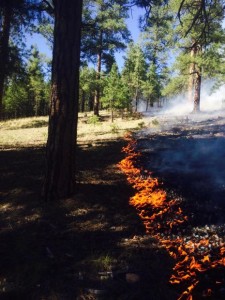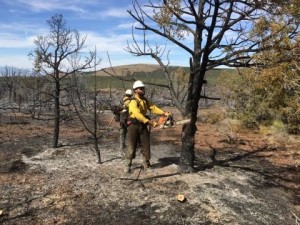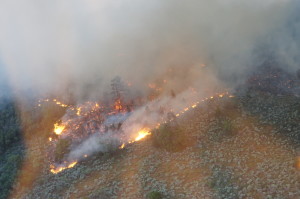
ST. GEORGE – Over the hot summer months, wildland firefighters work to establish, reinforce and hold the line around wildfires, managing them as they remove excess fuels from the forest floor, and making these portions of the forest healthier and safer for visitors.
“Wildfire is a commodity that we can’t afford to live without,” said Dave Robinson, Kaibab National Forest and Grand Canyon National Park fuels specialist. “So we do our best to manage these naturally-caused fires by manipulating the fire and keeping it at the low-and-slow intensity we want so nature can run its course.”

Wildfire benefits
This natural disturbance process, Robinson said, allows fire to reduce excess fuels, lessen the risk of future high-intensity wildfires and allow fire to return to the ecosystem safely and effectively in an environment that needs fire to remain healthy.
Objectives for a lightning-caused wildfire can call for full suppression, allowing the fire to take its natural course or a combination of the two. However, this decision can be challenging because it includes a number of complexities firefighters must take into account when planning these operations.
Such complexities can include landscape, terrain and weather, Robinson said. Other complexities to consider are public health risks and values at risk, such as historic landmarks, power lines, communication towers, local businesses and privately-owned properties in or near the location of the wildfire, also referred to as the Wildland-Urban Interface or the transition zone between unoccupied land and human development.
Managing the blaze
When conditions are right and deemed appropriate to manage, management action objectives often include returning fire to a fire-adapted ecosystem and reducing accumulated fuels on the forest floor; recycling of nutrients into the soil; enhancing wildlife habitat; and protecting the area from future high-intensity wildland fires.

In addition to reducing fuel surface loads on the ground, Robinson said, “it is necessary to open the tree canopy and reduce understory tree densities in the planning area, resulting in a mosaic of patches and corridors of trees and diversity of distribution and abundance of different plant and animal communities and species within the area covered by the LRMP.”
On the Burnt Complex fires this summer, Robinson said, this was accomplished by reducing the number of pole-sized trees, a term used to describe trees 6 inches in diameter or less.
Burnt Complex and Locust Fire progress
Over the last six weeks, wildland firefighters worked to establish, reinforce and hold the line around the 3,915-acre planning area on the Burnt Complex fire. They successfully achieved this management goal on Aug. 5.
Earlier in this wildfire season, firefighters also successfully managed the Locust Fire, which consumed more than 3,227 acres of excess pine litter and dead woody debris on the forest floor.
“Collectively,” Robinson said, “I can safely estimate both these wildfires removed approximately 5 to 10 tons per acre of excess fuels from the forest floor, making these portions of our forest healthier, more resilient to future wildfires and overall safer for those visiting the forest.”

Caution in the hot spots
Both the Burnt Complex and the Locust Fire continue to be in monitor and patrol status, and fire managers are asking forest visitors to avoid entering the recently burned area as interior fuels may still be putting out heat and smoke.
“Successful management of these lightning-caused fires starts with communication and information. Firefighter and public safety is always the most important consideration as part of that process,” said North Zone Fire Management Officer Ed Hiatt.
“We want our visitors to understand that even though a recently burned area may look like a safe place to explore, it isn’t,” Hiatt said. “There may be fire-weakened tree hazards overhead or stump-hole hazards on the ground, which can cause serious injury, so it is always best to be aware of your surroundings, be on the lookout for such hazards and use extreme caution if hiking or camping in the vicinity.”
Related posts
- Bird blamed for 50-acre fire in Cedar City
- Springs Fire grows into Wild Horse Canyon, smoke impacts
- Dry weather increases activity on Rock Fire
Email: [email protected]
Twitter: @STGnews
Copyright St. George News, SaintGeorgeUtah.com LLC, 2015, all rights reserved.
USFS, NATIVE BORN NEW MEXICAN scoffs at your science based approach to forest management. NATIVE BORN NEW MEXICAN knows that only logging and comprehensive fire suppression is correct.
Native born New Mexican believes that logging and grazing absolutely should be used as a way to manage forest health and as a way to provide resources and jobs to the communities surrounding the forest. Native born New Mexican also believes that lightening caused fires should not be allowed to get out of control and do real harm like what happened to New Harmony a few years ago. Native born New Mexican believes that a fire should never be set on purpose. Native knows of many well intended controlled burns that ended up having horrible consequences. In one case for sure Native knows the names and the faces of the stupid government officials who started a controlled burn on a windy spring day when most smart people would not even burn their garbage. They had a really good fire going and they did a lot of damage. I know I saw the damage and by using a freedom of information request I made public in court all the stupid things that were done and all the lies that were told by the above mentioned people.
Spot on as usual NATIVE BORN NEW MEXICAN. Loggers always take time to pick up and remove the flammable duff off the forest floor. Likewise, cattle have an uncontrollable craving for dried pine needles and Ponderosa Pine sprouts.
.
God bless the common folk like NATIVE BORN NEW MEXICAN who inherently possess the wisdom and knowledge which the college educated, career scientists at USFS lack. One can only hope that NATIVE BORN NEW MEXICAN will share this home-grown intuition with the professionals in other fields like cardiology, materials science and theoretical physics.
Who doesn’t love firefighters? Hello, looking forward to a calendar 🙂
Suppression is what has led to heavy fuels – fire is a natural part of the eco system